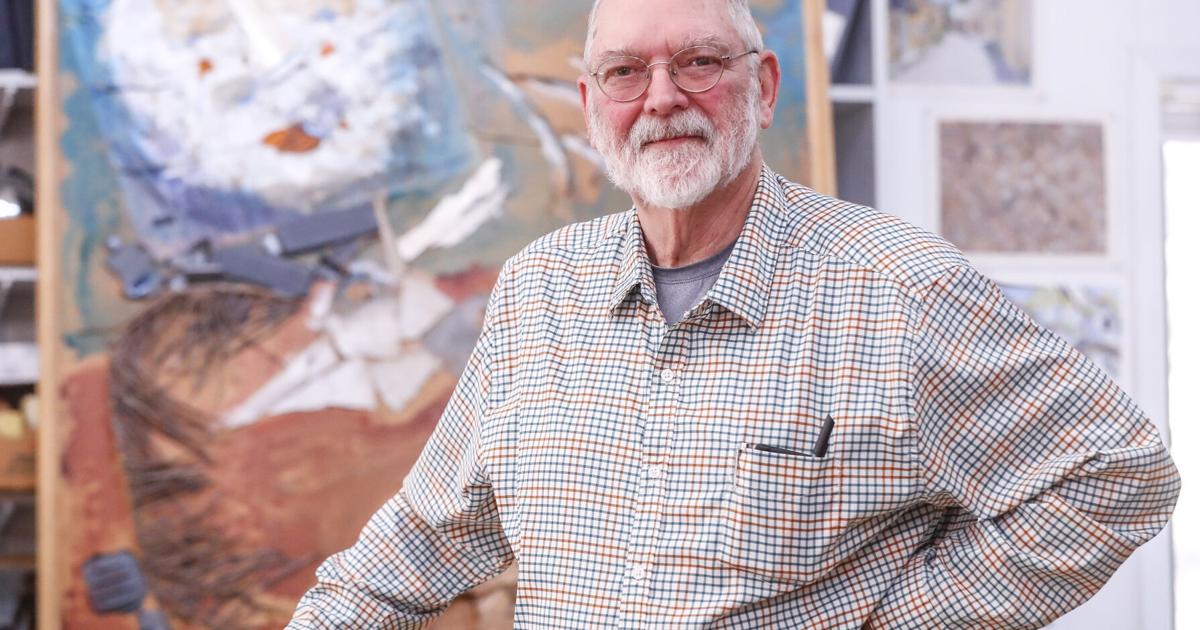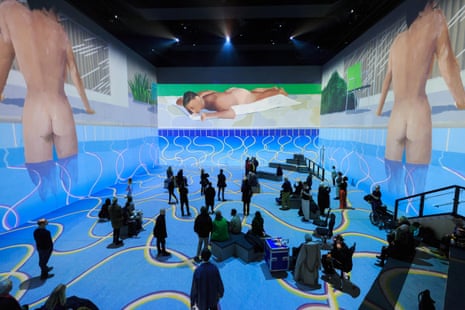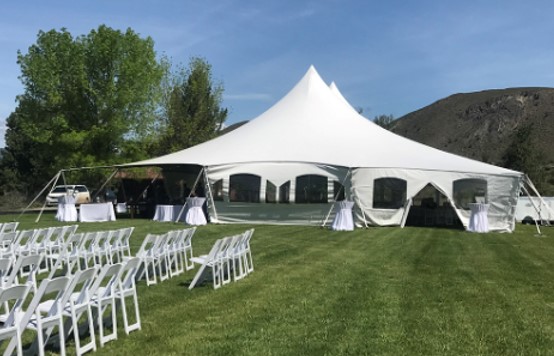CEDAR FALLS — Frje Echeverria’s studio brims with souvenirs from a recent vacation spent in Venice, Italy, but he didn’t stuff his luggage with Murano glass, lace, Venetian masks or even a gondolier’s hat as a trophy.
Instead, Echeverria brought home the canvases he painted along with drawings, rough sketches and notes jotted down in his journal while on a working vacation in Venice. The paintings depict historic Italian Gothic and Renaissance architecture along the Canal, infused with light and evocative colors.

University of Northern Iowa professor emeritus Frje Echeverria talks about his approach to his upcoming workshop, “Seeing Pairs and Following Threads,” at the Hearst Center for the Arts.
Some of these Venetian paintings may show up in Echeverria’s upcoming Hearst Center for the Arts workshops, “Seeing Pairs and Following Threads,” which begins Jan. 31 and runs through Feb. 21. The free program meets Tuesdays from 4 to 6 p.m. at the Hearst Center, 304 W. Seerley Blvd. It is open to all ages; pre-registration is required.
People are also reading…
Like pulling a loose thread on a tapestry, Echeverria hopes to unravel traditional perspectives of studying art based on focal point, color harmony, interpretation and analysis, for example, and focus instead on the stitches – lines, shapes, patterns, textures – as a means of exploring visual form, ideas and multiplicity.
The University of Northern Iowa professor emeritus has always been intrigued by how creativity happens and ways to encourage exploration and discovery. In the classroom, he encouraged young artist to learn to see without telling them what to see. The Hearst Center workshops is a natural extension of his interest in expression, experimentation and investigation.
The price of breakfast in America is on the rise.
“For me, it is to see if one can keep their eyes open without fixing or solidifying an idea of what we’re seeing,” said Echeverria. “What I love about art is the imagery, the association and influences. How long can a piece let us stay engaged and involved? Exploring visual form and ideas, multiplicity? The main thing is being open to seeing and recognizing threads.
“You notice three lines on one painting, for example, and see if you can see the threads and variations of lines that may appear in different places on the painting. Can we follow the threads? I want to see, examine and follow the threads, the details of what I’m seeing,” he explained.
Echeverria painted his Venetian works while seated with the canvases propped in his lap, “so I get drips of paint on the canvas from making the work. So, you notice a drip or drop of paint and you think the brush must have been here to make that shape. And here’s another but it looks different and, suddenly, you’re following threads.”

University of Northern Iowa professor emeritus Frje Echeverria’s studio at his home in Cedar Falls.
Echeverria said he’ll wait until the last minute to choose the art he wants to bring to the workshops. “I’ll cull what seems most alive to me at the moment, and that in itself opens up a greater awareness from me. What is interesting is the focus on a work is very different from simply talking about a piece.”
Art materials will be provided for participants to experiment with topics presented.
Echeverria’s career spans nearly six decades. A prolific artist, his works number in the thousands in various media, including pastels, acrylic, charcoal and mixed media. His work is in private collections and galleries and was the subject of a retrospective exhibit in 2008 at the UNI Gallery of Art, “Four Decades of Working Beside Students.”
Pre-registration is available online at www.thehearst.org, by calling (319) 273-8641, or at the Hearst Center.
PHOTOS Treasure Chest of wonderful, weird objects at Cedar Valley museums, galleries
WCA 1

Waterloo Center for the Arts Curator Chawne Paige holds “Running Jaguar and the Mystery of the Cob,” created by Jacobo and Maria Angeles from Oaxaca, Mexico, a piece in the center’s permanent collection.
WCA 5

Sculptures in storage at the Waterloo Center for the Arts’ permanent collection.
WCA 3

Marvin Cone’s “I Have Loved the Unloved” is on display at the Waterloo Center for the Art’s gallery.
WCA 2

Waterloo Center for the Arts Curator Chawne Paige and Registrar Elizabeth Andrews unpack a new addition to the center’s collection.
Cedar Falls Historical 1

Julie Huffman-Klinkowitz, collections manager at the Cedar Falls Historical Society, pulls a coat made from stallion hide out of its storage box on April 21 in Cedar Falls.
Cedar Falls Historical 2

The coat, which belonged to Mathias Sadler, a German who arrived in the United States in 1895, is part of the permanent collection at the Cedar Falls Historical Society.
Cedar Falls Historical 3

A woman’s three-speed bicycle made by John Deere that dates from 1972-1978, was recently donated to the historical society.
Cedar Falls Historical 4

A storage area in the Cedar Falls Historical Society.
Cedar Falls Historical 5

A garment storage area in the Cedar Falls Historical Society.
UNI Art 1

University of Northern Iowa Gallery of Art Director Darrell Taylor removes a Robert Rauschenberg lithograph, titled “Post Rally, edition 36/42,” from an archive shelf on April 8 in Cedar Falls.
UNI Art 3

University of Northern Iowa Gallery of Art Director Darrell Taylor uncovers a piece from the gallery’s collection on April 8 in Cedar Falls.
UNI Art 4

University of Northern Iowa Gallery of Art Director Darrell Taylor talks about new additions to the gallery’s collection on April 8 in Cedar Falls.
100820bp-uni-gallery-art-6

Rembrandt etching at the UNI Gallery of Art.
100820bp-uni-gallery-art-5

John Dabour pastel on canvas on board-UNI Gallery of Art. Photographed Thursday, Oct. 8, 2020, in Cedar Falls, IA.
100820bp-uni-gallery-art-7

Gregorian chant vellum and ink-UNI Gallery of Art. Photographed Thursday, Oct. 8, 2020, in Cedar Falls, IA.
100820bp-uni-gallery-art-4

George Grosz watercolor and ink on paper-UNI Gallery of Art in Cedar Falls.
Grout 1

Nicholas Erickson, Grout Museum of History and Science registrar, lifts a doll out of a toy box belonging to Diane Broessel, who grew up in Waterloo in the 1940s.
Grout 2

Nicholas Erickson, Grout Museum of History and Science registrar, handles a rifle from the museum’s collection.
Grout 3

Nicholas Erickson, Grout Museum of History and Science registrar, looks over one of the museum’s storage rooms.
Grout 4

One of the storage rooms at the Grout Museum of History and Science.
Grout 5

Nicholas Erickson, Grout Museum of History and Science registrar, places a boxed quilt back onto a shelf in one of the museum’s storage rooms.
Hearst 1

Emily Drennen, the curator/registrar for the Hearst Center of the Arts, holds up a water color painting by Marjorie Nuhn titled “Atalya Hill, Santa Fe,” a piece in the center’s permanent collection.
Hearst 2

A storage room in the Hearst Center of the Arts holds many pieces of the center’s permanent collection.
Hearst 3

Emily Drennen, the curator/registrar for the Hearst Center of the Arts, looks over Ruth Hardinger’s “Tres Tiempos,” a new acquisition for the center’s permanent collection.





More Stories
Special Tour “Painting History” Showcases Two Exhibitions at The Hood: “Historical Imaginary” and “Kent Monkman: The Great Mystery”
The Ambassadors by Hans Holbein the Younger | History Of The Painting
14 Groundbreaking African American Artists That Shaped History